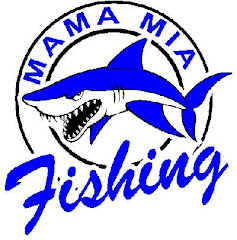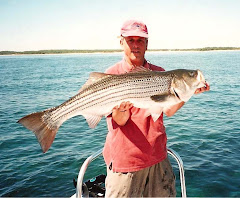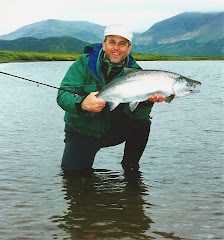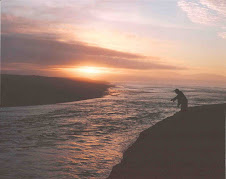 Some of the best Alaska fly-fishing can be enjoyed during the early fall months. September and October can spectacular for silver salmon and rainbow trout. And in some locations the latter part of October can be magical with steelhead. The remote tidal creeks of the Alaska Peninsula and Kodiak Island can be teeming with late arriving cohos, some of the finest you will find in the state, and some of the best fly fishing you will ever experience. The Lost Coast anchored by the town of Cordova not only yields some of the largest silvers of the Northland but also has a wonderful steelhead fishery. If rainbows are your cup of tea the Iliamna region of Bristol Bay can be magnificent. Byt the Katmai region is a personal favorite.
Some of the best Alaska fly-fishing can be enjoyed during the early fall months. September and October can spectacular for silver salmon and rainbow trout. And in some locations the latter part of October can be magical with steelhead. The remote tidal creeks of the Alaska Peninsula and Kodiak Island can be teeming with late arriving cohos, some of the finest you will find in the state, and some of the best fly fishing you will ever experience. The Lost Coast anchored by the town of Cordova not only yields some of the largest silvers of the Northland but also has a wonderful steelhead fishery. If rainbows are your cup of tea the Iliamna region of Bristol Bay can be magnificent. Byt the Katmai region is a personal favorite.
Sunday, August 30, 2009
Fall in Alaska
 Some of the best Alaska fly-fishing can be enjoyed during the early fall months. September and October can spectacular for silver salmon and rainbow trout. And in some locations the latter part of October can be magical with steelhead. The remote tidal creeks of the Alaska Peninsula and Kodiak Island can be teeming with late arriving cohos, some of the finest you will find in the state, and some of the best fly fishing you will ever experience. The Lost Coast anchored by the town of Cordova not only yields some of the largest silvers of the Northland but also has a wonderful steelhead fishery. If rainbows are your cup of tea the Iliamna region of Bristol Bay can be magnificent. Byt the Katmai region is a personal favorite.
Some of the best Alaska fly-fishing can be enjoyed during the early fall months. September and October can spectacular for silver salmon and rainbow trout. And in some locations the latter part of October can be magical with steelhead. The remote tidal creeks of the Alaska Peninsula and Kodiak Island can be teeming with late arriving cohos, some of the finest you will find in the state, and some of the best fly fishing you will ever experience. The Lost Coast anchored by the town of Cordova not only yields some of the largest silvers of the Northland but also has a wonderful steelhead fishery. If rainbows are your cup of tea the Iliamna region of Bristol Bay can be magnificent. Byt the Katmai region is a personal favorite.
Friday, August 28, 2009
Inshore "Bones"

It’s time to make your bones? Atlantic “bones” that is. For some savvy anglers this is time to give chase to pelagic speedsters that grace our inshore waters. The first of those species to arrive is Sarda sarda, the Atlantic bonito. As of this writing the bulk of those annual visitors are slightly to our north on the south shore of Rhode Island, on the Vineyard, and south of us along the New Jersey beaches. There are plenty of fish in those locations because there is also substantial bait. Some very in-the-know Long Island anglers have been fortunate to find the first few fish and have also been very closed-mouth about exact locations. But I can tell you from personal experience, they are not yet in all the “usual places”. The best advice that I can offer those willing to search and find bonito is to fill up your gas tank and be prepared to run it dry. Bonito are cruising deeper water in the Sound and off the south shore and have yet to cycle into their more predictable inshore haunts. Since my boat is high and dry at the moment I hitched a ride with a friend and we ran almost an hour before bumping some fish! They were in a place I haven’t found them in years. There are a lot of reasons for that change of behavior but we don’t have room to go into that in this report. I’ll save that for another time. If you’d like to chat about bonito feel free to send along an email.
I took a break from the brine to join my brother-in-law, Ed on a trip to one of Long Island’s hidden freshwater ponds. Despite sweltering heat we managed a number of feisty largemouth and pickerel, and we were treated to a dragonfly mating ritual that just turned the bass on!
I took a break from the brine to join my brother-in-law, Ed on a trip to one of Long Island’s hidden freshwater ponds. Despite sweltering heat we managed a number of feisty largemouth and pickerel, and we were treated to a dragonfly mating ritual that just turned the bass on!
Friday, August 14, 2009

The table is set as we await the arrival of some eagerly anticipated special houseguests. Peanut bunker, bay anchovies, rafts of sand eels as well as spearing are in the neighborhood. Now all we need is the first solid showing of inshore pelagics. But this year they just might be delayed just a bit. Reports of one or two fish popping up here or there do not a major run make, but with all this varied bait buffet, it is only a matter of time before the arrival of strange “bluefish” that can’t be caught. Those tough-to-catch- mini tunas will most likely be Atlantic bonito. They too have a preferred water temperature comfort zone and with this year’s cooler H2O my bet is that there will be about a two-week lag from previous years’ full swing run of the early hard tails. In all the years I have been fishing for Atlantic bonito – and that goes back 1975- fish have already hit the decks! So, we need to keep our fingers crossed that they will still make a solid showing. But if all goes according to nature’s grand plan in an odd season we should see some bones, Spanish macks, albies and perhaps even some skipjack move in the area to cash in on all the bait that is in our area. Some fish have already passed us by and are up in the Cape and the Vineyard; to those fish we bid a fond adieu and hope their cousins stop by the Island for a visit. Both sides of the Island receive their annual share of these most coveted of inshore gamesters. That said, there are already fish in the neighborhood so this is the time of year to start prospecting so get out those light spinning outfits and fly rods and hit the water. Small tins, plugs and thin plastics work well on pelagics as do slim Deceivers, Clousers, and any assortment of epoxy baitfish, hair flies, and marabou or rabbit strip flies.
Subscribe to:
Posts (Atom)










